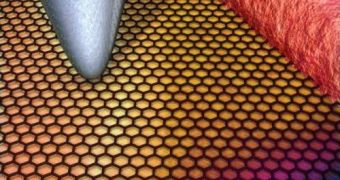Physicists at the University of Illinois in Urbana-Champaign (UIUC) have recently demonstrated the existence of a nanoscale cooling effect inside transistors made of graphene. These structures are apparently capable of reducing their own temperatures, the team reveals.
These are the first observations of such thermoelectric effects taking place at the point of contact between graphene transistors. The findings has tremendous implications for the electronics industry.
At this point, the issue with computers is that the degree of miniaturization today's technology allows is creating transistors that get extremely hot during normal operations. They are cooled actively via fans or water-based systems, and these systems consume a lot of power.
Regular transistors heat due to a process called resistive heating, which occurs when electrons flowing through the devices are impeded from passing right through. This generates loss, and is one of the main reasons why everything electronic today heats up.
There are some thermoelectric effects in regular transistors that also cool down the device, but the influence of resistive heating far outweighs these effects, explains UIUC mechanical science and engineering professor William King, the leader of the new research.
Eric Pop, a professor of electrical and computer engineering at the university, was the other leader of the study. The new work is published in the April 3 advance online issue of the top journal Nature Nanotechnology, EurekAlert reports.
At this point, they say, the electronics industry is headed towards replacing silicon with graphene as the main material transistors are made of. The latter is a compound of carbon, which has a hexagonal shape, no resistivity to passing current, and the strongest structure ever discovered in nature.
Due to the fact that graphene is only one-atom thick, experts have yet to fully grasp the complexity of phenomena involving the generation and distribution of heat inside this material. The carbon compound was only discovered 6 years ago, and there are still many things to learn about it.
In the new investigation, the UIUC team used the tip of an atomic force microscope (AFM) to measure the temperature of a working graphene transistor. What was found surprised even the researchers.
At the point of contact between graphene transistors and their metal connection, thermoelectric cooling effects were predominant over resistive heating. This means that the temperature of the transistor itself was actually dropping while operating, rather than increasing as it does in silicon-based transistors.
“In silicon and most materials, the electronic heating is much larger than the self-cooling. However, we found that in these graphene transistors, there are regions where the thermoelectric cooling can be larger than the resistive heating, which allows these devices to cool themselves,” King says.
“This self-cooling has not previously been seen for graphene devices,” he adds.
“Graphene electronics are still in their infancy; however, our measurements and simulations project that thermoelectric effects will become enhanced as graphene transistor technology and contacts improve,” Pop adds.

 14 DAY TRIAL //
14 DAY TRIAL //